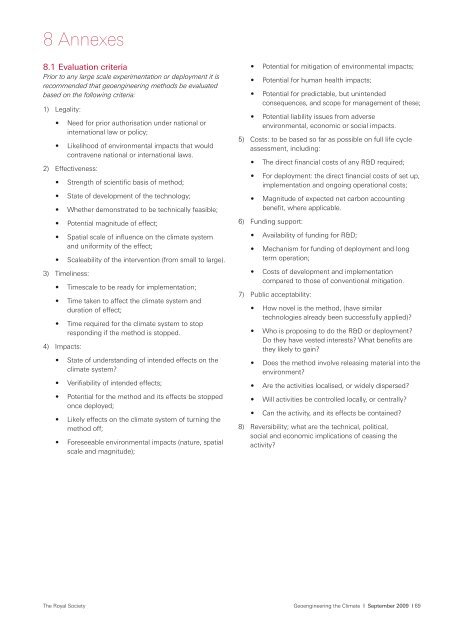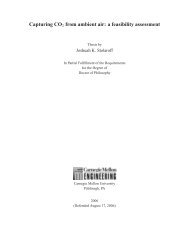Royal Society - David Keith
Royal Society - David Keith
Royal Society - David Keith
You also want an ePaper? Increase the reach of your titles
YUMPU automatically turns print PDFs into web optimized ePapers that Google loves.
8 Annexes<br />
8.1 Evaluation criteria<br />
Prior to any large scale experimentation or deployment it is<br />
recommended that geoengineering methods be evaluated<br />
based on the following criteria:<br />
1) Legality:<br />
• Need for prior authorisation under national or<br />
international law or policy;<br />
• Likelihood of environmental impacts that would<br />
contravene national or international laws.<br />
2) Effectiveness:<br />
• Strength of scientific basis of method;<br />
• State of development of the technology;<br />
• Whether demonstrated to be technically feasible;<br />
• Potential magnitude of effect;<br />
• Spatial scale of influence on the climate system<br />
and uniformity of the effect;<br />
• Scaleability of the intervention (from small to large).<br />
3) Timeliness:<br />
• Timescale to be ready for implementation;<br />
• Time taken to affect the climate system and<br />
duration of effect;<br />
• Time required for the climate system to stop<br />
responding if the method is stopped.<br />
4) Impacts:<br />
• State of understanding of intended effects on the<br />
climate system?<br />
• Verifiability of intended effects;<br />
• Potential for the method and its effects be stopped<br />
once deployed;<br />
• Likely effects on the climate system of turning the<br />
method off;<br />
• Foreseeable environmental impacts (nature, spatial<br />
scale and magnitude);<br />
• Potential for mitigation of environmental impacts;<br />
• Potential for human health impacts;<br />
• Potential for predictable, but unintended<br />
consequences, and scope for management of these;<br />
• Potential liability issues from adverse<br />
environmental, economic or social impacts.<br />
5) Costs: to be based so far as possible on full life cycle<br />
assessment, including:<br />
• The direct financial costs of any R&D required;<br />
• For deployment: the direct financial costs of set up,<br />
implementation and ongoing operational costs;<br />
• Magnitude of expected net carbon accounting<br />
benefit, where applicable.<br />
6) Funding support:<br />
• Availability of funding for R&D;<br />
• Mechanism for funding of deployment and long<br />
term operation;<br />
• Costs of development and implementation<br />
compared to those of conventional mitigation.<br />
7) Public acceptability:<br />
• How novel is the method, (have similar<br />
technologies already been successfully applied)?<br />
• Who is proposing to do the R&D or deployment?<br />
Do they have vested interests? What benefits are<br />
they likely to gain?<br />
• Does the method involve releasing material into the<br />
environment?<br />
• Are the activities localised, or widely dispersed?<br />
• Will activities be controlled locally, or centrally?<br />
• Can the activity, and its effects be contained?<br />
8) Reversibility; what are the technical, political,<br />
social and economic implications of ceasing the<br />
activity?<br />
The <strong>Royal</strong> <strong>Society</strong><br />
Geoengineering the Climate I September 2009 I 69








